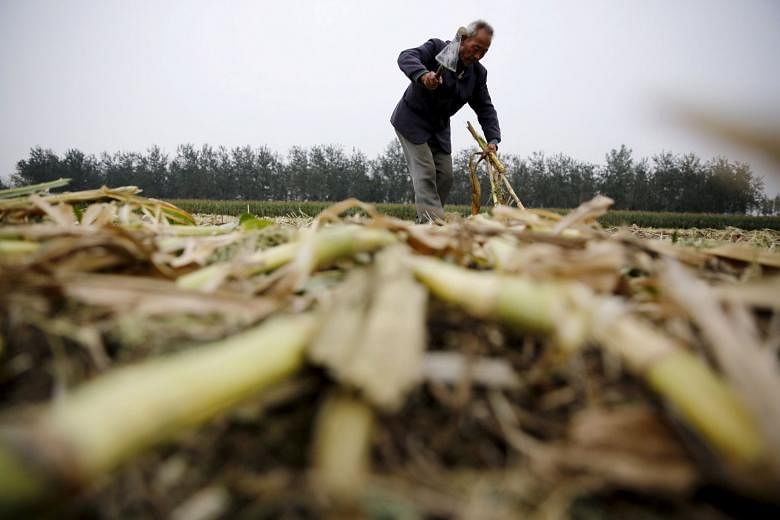Yang Yang, a 22-year-old Chinese corn farmer, spends two to three hours per day streaming video of life in his cliffside village to smartphones across China.
He spends lots of time clinging to a cliffside ladder, one hand on his selfie stick, while he banters with fans about village life.
It's hardly riveting television, but in China it has an audience.
In just two months, Yang has managed to earn more than one million views and 45,000 regular followers on Kuaishou, an online video app favoured by the 73 per cent of Chinese who live in small cities and villages.
That's a lot of people.
Kuaishou claims it has 700 million registered users who upload 10 million videos per day. But rather than being celebrated for its focus on China's economically and culturally marginalised majority, Kuaishou has been derided by China's educated urban elite. That's a mistake. China's countryside is growing faster than its big cities and the economic gap between urban and rural is narrowing.
If China's intellectuals don't respect that fact, its investors certainly do. In recent weeks, Chinese media reported rumours that Beijing Kuaishou Technology, Kuaishou's developer, is seeking new funding at an estimated valuation of US$15 billion (S$20.1 billion), which would make it one of the world's more valuable start-ups.
Kuaishou is the unlikeliest of Chinese Internet success stories. Founded in 2011 as a photo app, the company pivoted to becoming a video-sharing platform in 2013. It was good timing. Chinese smartphone owners were starting to make - and watch - millions of videos and livestreams per year, often to lucrative effect.
Last year, revenues for the sector exceeded US$9 billion, up 43.4 per cent from 2015.
The most successful of these videos and streams combine the power of Chinese social media with snappy, humorous film-making often focused on celebrity, fashion and urban life. Luxury advertisers, in particular, are keen to reach young and affluent people attracted by this programming. And young, affluent Chinese are keen to post their own videos to enjoy a bit of glamour by association.
But that's not a description of the typical Kuaishou enthusiast. According to one analysis, 70 per cent of Kuaishou's users earn less than US$460 per month, 88 per cent haven't attended university, and a majority live in less developed parts of China.
Kuaishou has managed to attract them by forgoing celebrity videos and promoted content in favour of algorithms that recommend items that other users like.
It's an approach that leaves users with the impression (if not the reality) that their videos have a fighting chance to be viewed. And that attracts users who know they'd be wasting their time posting content to sites focused on fashion, luxury and city life.
The approach boosts content quite unlike the displays of aspirational opulence featured on other Chinese video sites. Indeed, the platform is best known for videos that, in the words of one anthropologist, emphasise "crude humour" that "reflects the lower socioeconomic backgrounds of the app's subscribers".
The most popular of these wouldn't be out of place on Jackass, the American reality show. There are short clips of men shoving firecrackers down their pants, and an infamous set of videos in which a 45-year-old mother eats lightbulbs, a cactus and mealworms.
There's weightier stuff, too, like a harsh kind of protest rap focused on discrimination against China's less fortunate (especially when it comes to dating), and videos that highlight rarely aired negative social phenomena like teenage pregnancy. Crudity, in this sense, is just reality for most Chinese - and the primary reason that Kuaishou has been so successful.
Indeed, even as other video platforms see their growth stunted by Chinese government oversight and brutal competition, Kuaishou expands. Today it's the fourth-largest social-media platform in China, behind WeChat, QQ and Sina Weibo.
That's why it's a smart bet for investors like Tencent Holdings, which pumped in US$350 million in March.
China's smaller cities already produce 59 per cent of China's gross domestic product and retain significant commercial and cultural pull, both for those who still live in them and for the hundreds of millions who've migrated away.
China's big-city skylines may get most of the attention, but government-led investment drives focused on China's countryside and smaller cities ensure that neglected demographic groups will exert increasing influence on China's economic and cultural future.
Kuaishou, having established itself as the platform for China's overlooked majority, is poised to become the voice of that affluent future.
BLOOMBERG VIEW

